It’s now a few months since Brighton-based Littleloud Games released Sweatshop, a charming and witty yet often bleak game cast, in part, from the tower defence mould. Version 1.1 of the game is on the verge of release, bringing with it a shipment of uniformly-stitched bug fixes, gameplay improvements and Kongregate integration. Taking a short break from cracking the whip over ranks of blank-faced child artists and developers, Littleloud’s Creative Director Darren Garrett took a few minutes to answer some of Arcadian Rhythms’ questions about the game.
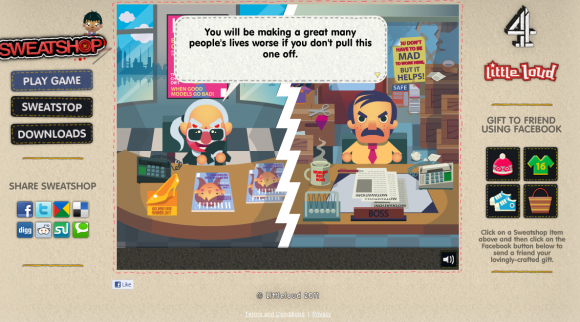
AR: I’ll open proceedings up with the traditional question: please could you introduce yourselves and summarise your involvement with Sweatshop to our readers?
DG: Hello. My name is Darren Garrett and I’m the Creative Director of Littleloud. I’ve been working on Sweatshop as executive producer, director, animator and master of morale-boosting biscuit runs. I worked closely with Simon Parkin, game designer, as part of a small crack unit over 8 months development.
AR:Â How did you find working with Channel 4 Education? I gather it’s not the first time you’ve worked with them (The Curfew springs to mind)
DG:Â It’s our third large project with the team at Channel 4 Education. The first was Bow Street Runner (looking at life, police work, violence, gangs and prostitution through the eyes of a Bow Street Runner in Georgian London), followed by The Curfew (civil liberties through the eyes of four people set in a dystopian future England).
They are a brilliant team and it is a highly collaborative situation. Ultimately they show great trust in us to deliver something exciting and different. As a broadcaster they also aren’t afraid of looking at controversial or difficult situations and that suits us fine.
AR:Â When you started this project was a tower defence game on the cards from the beginning, or did you find yourself experimenting with different ideas to see what fit the subject matter?
DG:Â We knew it would be some variation on that theme, but a strategy based on creating rather than destroying. The key was to recreate a pressured factory environment where the winning gameplay decisions might be at odds with your own personal morals.
What I’m really interested in is narrative and emotional involvement in games. The interesting thing about playing this game is that, as well as the story arc, every player is really creating their own stories. I know that happens in a lot of games, but often not often in such a way that makes them question their own game strategies.
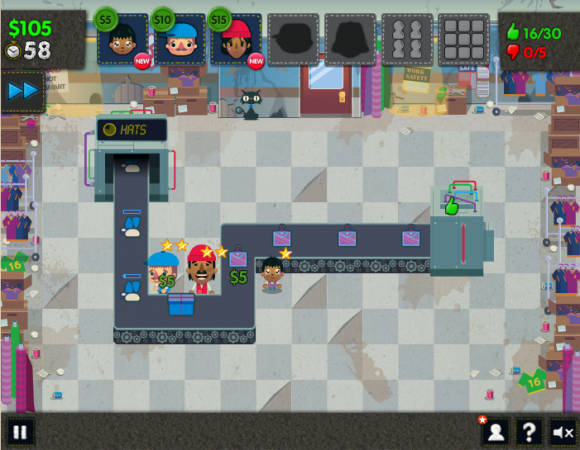
AR:Â The integration of real-world issues into games represents a substantial challenge, and it’s easy to trip yourself up. Were there any issues or difficulties during development that took you back to the drawing board?
DG:Â Luckily no. We’d done quite a lot of research and reading around the subject plus consulted with Labour Behind the Label to make sure that what we have is essentially an accurate description of how things work. I’d say there were tweaks and refinement but there was never a point where we were so way off we had to scrap anything.
What we did find though, is that we couldn’t get every factor into the gameplay. They either proved too tricky or complex to work in. For example the lack of unions and the techniques that are used to discourage their formation. However we had our factory manager, Boss, to vocalise his dislike of such workers rights.
AR:Â It seems that in recent years, among those who don’t habitually follow this sort of thing, the focus has shifted away from sweatshops and similar methods of grossly exploitative production. Is it your hope that Sweatshop will help restore some much-needed attention to this issue?
DG:Â That is part of it. Issues unfortunately go in and out of fashion (if you forgive the pun), but the problem is still there.
What I was really interested in was what actually drives sweatshop conditions: our desire for mass produced cheap clothing and products, the behavior of companies who deal with factories who can use competition to drive down costs and force deadlines.
We tried to introduce this concept in the character arc of Boss, who starts off quite unsympathetic and two dimensional. However it becomes apparent who is in fact the real boss, and who is really driving conditions on the factory floor.
Also, solutions are not as simple as closing all sweatshops of sacking all child workers. The consequences of this can be even worse. Essentially it’s about corporations ethical behaviour and allowing conditions to evolve and improve. It’s worth pointing out that every developing industrial nation has had sweatshops at some point.
Luckily there are charities who compile annual reports on the behaviour of all your favourite companies. Well worth searching for.

AR:Â So do tell – who produced all of your art assets? Hopefully not a team of Chinese Flash artists working in a graphics mill…
DG:Â Erm, HAHHAHHA. No.
Next question.
OK. OK. We ethically sourced a highly talented artist by the name of Gary Lucken (armyoftrolls.co.uk). He primarily creates beautiful and painstakingly detailed pixel artworks (I have some above my desk), but for his project he in fact developed a whole new vector-based style.
If he outsourced some of the art to his enclave of tiny pixel slaves you’ll have to take it up with him.
AR:Â There’s a slight spoiler here, so I’m including this preamble so that readers who want to experience the full game for themselves can avert their eyes. One thing I found particularly interesting about Sweatshop was the way in which the factory boss is at the mercy of his international paymasters just as the factory workers are at his. Obviously there’s a huge difference between their respective quality of life and freedom, but that sense of being forced into a situation is conveyed well. One of the difficulties of tackling sweatshop labour is in recognising that the problem is systemic; sweatshops are symptoms of a larger problem with globalised capital and labour. Am I reading too much into the game or is this something you wanted to explore?
DG:Â Brilliant. No, you’ve totally nailed it and put in much more eloquent terms than I could ever muster. That is exactly what we wanted to emerge over the 30 levels of play. It is a complex issue without easy fixes. We certainly don’t offer answers but what we aim to do is make people think while they’re having fun.
AR:Â Games have a tendency to dehumanise the characters that we command, and it’s easy to forget that the characters you’re controlling represent people when you’re commanding them to fight to the death or work their fingers to the bone. The late-game dialogue concerning Doris was a slap in the face for me for this reason, and I’d also like to hear your thoughts on this.
DG:Â We put a lot of work into the story arc and Simon worked very hard on nailing this in the scripts, so this is great to hear.
At the outset we had numerous ideas about how to humanise the ‘units’, but it really came down to Boss and Boy to create those moments that make you step back from the game and the constant demand to succeed with the best score, to make you consider the cost.
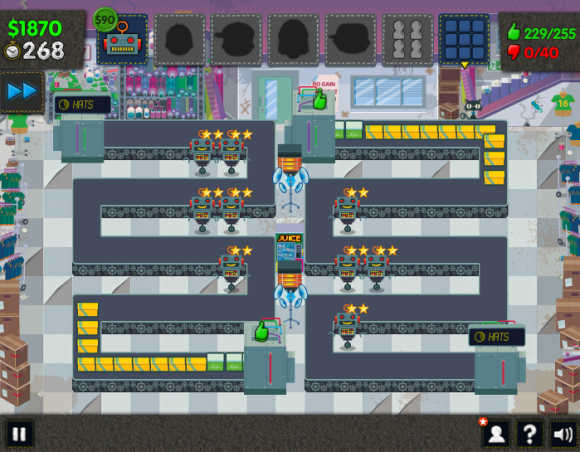
AR:Â Are there any other aspects of the game’s writing that you particularly enjoyed? Obviously there’s a lot of fairly risque humour in there – heavily worn photos of Emma Totson, anyone? – which I think will be great for engaging with teens and adults.
DG:Â Absolutely. If we made a dry game that did nothing but deliver facts it would turn the audience off pretty quickly. We know the audience well and work really hard to maintain the balance between the educational and fun.
But as well as the rudeness there is also real substance in the plot and character arcs. We want the player to be emotionally involved with the game and story. Really, that’s the key to engagement. Guilt-based gaming, perhaps?
AR:Â It’s a few weeks since its release now; how has the response been to the game?
DG:Â Absolutely amazing. Some brilliant reviews and massive amounts of players. Some of the comments in threads where people have played the game have been inspiring and incredibly touching.
What I hope is that Sweatshop contributes to the possibilities of what games can be and what they can achieve.
AR:Â I’ll also finish with a very traditional question… What’s coming up next for Littleloud?
DG:Â Gosh. Lot’s of fingers in many pies at the minute, but ultimately as long as we carry on innovating and exploring the possibilities of storytelling in games we’ll be very happy.
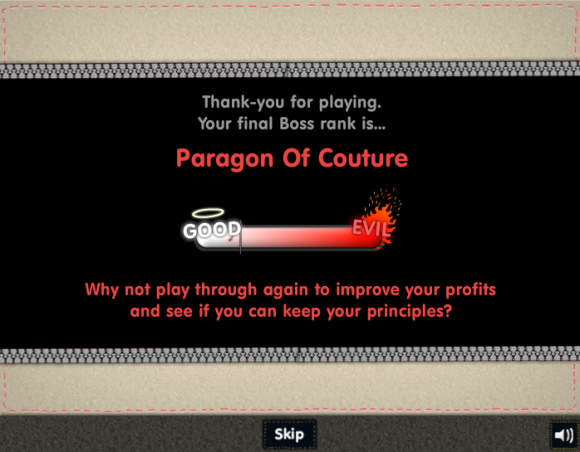
Many thanks to Darren for taking the time to answer my questions, and to Littleloud’s Kerry Turner for setting up the interview. Once again, you can check out Sweatshop here or over at Kongregate (complete with badges).
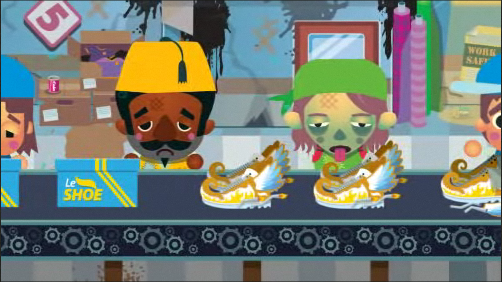
Comments
4 responses to “On the Assembly Line: An Interview with Littleloud’s Darren Garrett”
Nice interview. One thing I wanted to bring up:
'Happy, like my workers! I was a good Boss and only burned one worker to death by accident.'
So you are saying that you burnt all the others to death on purpose?
Uh-oh. My motivational technique has been rumbled.
And thanks!
You get the Paragon ending by burning all your workers that take Renegade actions.
[…] its removal from the App Store; a minor controversy in line with the removal of other titles like Sweatshop HD and Phone Story. I’ve struggled to find an actual review of the game anywhere, with most […]